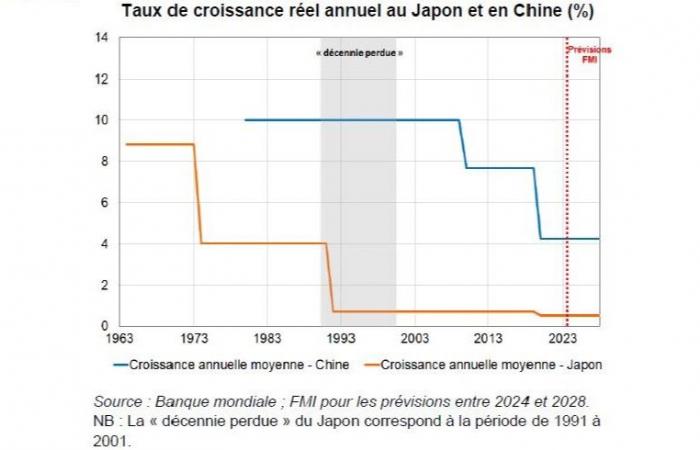The phenomenon of “Japanization” of a country refers to the economic trajectory that Japan experienced from the early 1990s, after several decades of rapid expansion. It is characterized by low growth and inflation rates, and extremely low interest rates.
China has several similarities with Japan in the early 1990s. Its growth model gives priority to industry and investment, and relies on the dynamism of exports. It is facing high debt, a sharp slowdown in its demographics, a downward trend in growth (cf. Chart) and inflation, and a real estate crisis since 2021.
However, the extent of the decline in growth could be more limited than in Japan, given certain strengths of the Chinese economy, and the possibility of learning from the Japanese experience. As it reaches the technological frontier in a growing number of sectors, China aims to transition to a new growth model, more focused on new technologies and increased productivity.
The implementation of this new model could, however, be hampered by the high debt rate of local governments, and questions remain more generally about the capacity of such a model to support a high level of growth.
A destiny comparable to that of Japan would mean a sharp slowdown in the catching-up process, but not necessarily lower productivity gains than in other countries: corrected for demographic structure, Japanese growth has in fact been similar to that of other major countries. advanced countries since 1990.
+ Download the complete Trésor-Éco study n° 352>>
+ Other publications to consult on the subject:
- Geng Z. et Pan J. (2023), “The SOE Premium and Government Support in China’s Credit Market”, NBER, Working Paper 26575.
- Carré T., Chalmel L., Villani E., Yang J. (2022), “The dependence of Chinese growth on the real estate sector”, Trésor-Econ° 311.
- Heng S.-H. (2009), “Insights from Japan’s “Lost Decade””, EAI Working paper No. 154.
- Alix T., Carré T., Chalmel L. (2023), “Chinese public finances: cyclical risks and structural issues”, Trésor-Econ° 327.






